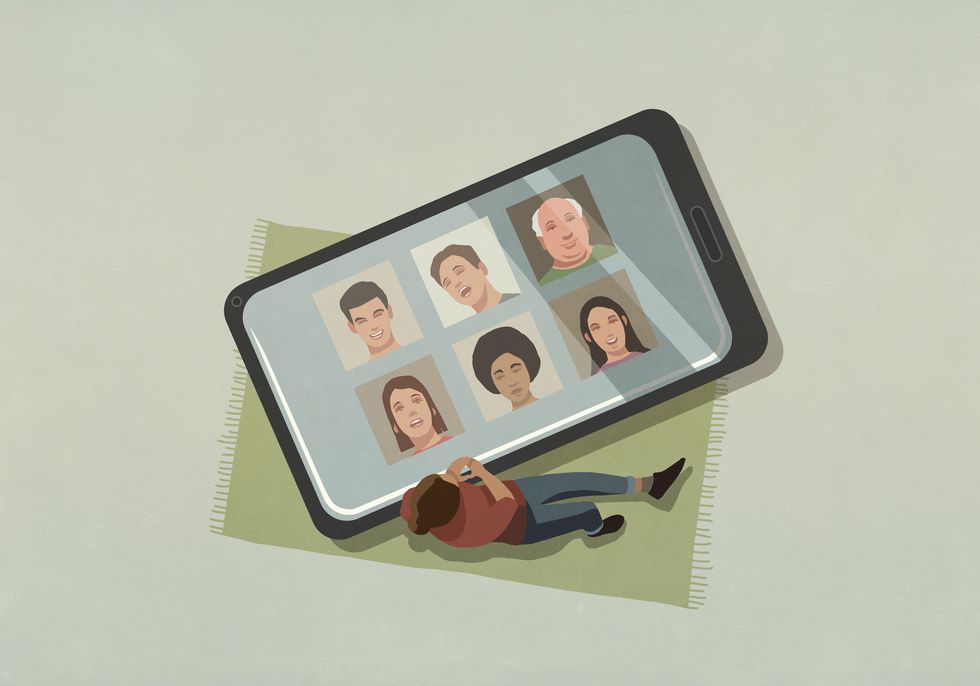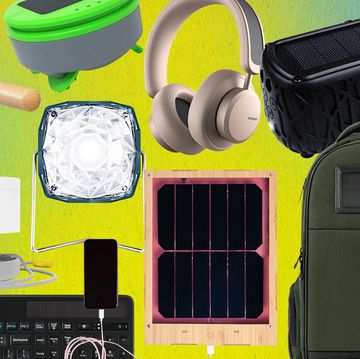When the U.S. screeched to a halt in March 2020 as a result of the pandemic, technology spared the world from a complete and total shutdown. From Zoom meetings to e-commerce to VR concerts, technology kept us connected and kept businesses running. We could continue taking workout classes via Instagram Live and Zoom, seeing our doctors face to face through video calls, and even hanging out together in virtual chat rooms. For those of us who live alone, it spared us from complete aloneness.
Given the reach technology has in every facet of our lives, and how central it’s been to our survival during Covid-19, Shondaland wanted to explore where tech is today, how we relate to it, where it’s headed, and the ways it will reshape our lives in the near future.
Holly Christopher has never been a fan of virtual communication.
“I hate being on camera so I have successfully avoided FaceTime pretty much since it came into existence,” she says. Living through a pandemic in Chicago, a city that has been in various stages of a socially-distant lockdown since March 13, 2020, hasn’t altered those feelings. Like most of us, however, her desire to stay connected during a time of scarce face-to-face interaction has forced a softening of her no-video-chat stance. “I have done some Zoom calls with family and friends. My husband and I even did a game night with some friends via Zoom that was chaotic but fun.”
Technology: A Shondaland Series
Technology has been altering our lives since the beginning of humanity. The wheel, the lightbulb, the iPhone. Every new tool our society adopts as a way to save time or money, or to make our lives easier and more fun, has altered the fabric of how we live. Even before COVID-19 turned the world upside down, it often felt like the must-have app or smart device changed daily. It took 100 years for the telephone to make it into more than 50% of households. Tablet computers reached that same saturation point in only five years.
Technological changes happen fast and furious in our modern world, but perhaps never more so than during the coronavirus pandemic. Especially when it comes to how we communicate. Christopher, a partner at Forage and Foster — an online shop selling ethically produced cheeses, meats, and specialty foods — says that a large slice of her business is selling wholesale to restaurants, and not being able to interact in-person with her partner and clients has been a struggle for her luddite tendencies.
“I don't feel like technology allows our working relationships to function as they would in person for the core part of our business,” she says. “We have great digital tools available that we used pre-Covid to help us communicate information clearly and quickly to a large base of accounts, but nothing compares to face-to-face meetings with chefs and buyers tasting products together. Our business is so heavily dependent upon solid relationships and it’s much harder to do now when most everyone is so stretched and stressed just trying to get through the day.”
Coronavirus has revolutionized how ordinary people utilize technology. It sparked an all-ages, instantaneous adoption of tech-first solutions in an effort to continue communicating, shopping, and living a healthy lifestyle without leaving home. It’s a switch that, now flipped, may never turn off again.
One-stop living via tech
Now that we’re primarily homebound, it’s all tech, all the time. Building and maintaining relationships via virtual means has become the baseline expectation, and tech companies are reaping the benefits.
Even as more than one million Americans file for unemployment every week, large swaths of the tech industry show no signs of slowing down. Giants such as Facebook and Google have seen their share prices soar. Netflix doubled their new subscriber goals, and Disney+ crossed the 60 million subscriber threshold. Even Microsoft reported a 15% sales increase. And it’s not limited to profits. Usage has soared, too, with daily traffic increases in the double digits for Facebook (27%), Netflix (16%), and YouTube (15.3%). Now that we all stay at home to do our business, personal, and pleasure activities via technology, demand for virtual content and communications tools has never been higher.
Virtual meetings have dominated the coronavirus tech space. Google Meets, join.me, GoToMeeting, and FaceTime have helped keep us connected. Zoom, perhaps the most ubiquitous tech company of the Covid-19 era, expects profits to double in the second quarter as the majority of work meetings, schools, virtual happy hours, yoga classes, and concerts have migrated to the platform. The company’s number of daily meeting participants grew from 10 million in December 2019 to 300 million as of April 2020.
“The pandemic broadened our view on what it means to be a video communications technology provider in times of need,” said a spokesperson for Zoom. “We knew that many organizations were grappling with how to maintain business continuity and keep employees engaged, and that individuals, educators, healthcare providers, and others were all searching for a way to stay connected.”
In response to K-12 schools switching to virtual learning in an instant, Zoom lifted the 40-minute limit on their no-cost, basic accounts for more than 100,000 schools in 25 countries.
The software has had its share of tribulations though, notoriously crashing under the weight of a huge increase in users as well as dealing with privacy concerns related to Zoombombing and compromised information. Even as they became the communication verb of the pandemic, Zoom corporate was undergoing the same transition as the majority of American’s workforce. “Until the pandemic, most of our teams worked in an office,” said their spokesperson.
The forced shift to virtual workplaces has required many employees and companies to become increasingly nimble. Holly McDaniel, executive director at Austin Diaper Bank, Texas, says that having staff, volunteers, and partner agencies move to more technology-based work environment has helped their overall capacity to give out diapers to families in need, but it also has created a hurdle for their clients.
“As families lost income and childcare, we saw an immediate increase in families reaching out to the diaper bank for help,” she says. The organization adjusted to the increasing number of clients while simultaneously prioritizing staff and volunteer safety. Microsoft Teams and Zoom allowed them to connect with their partner agencies and families.
“We have used technology to communicate quickly and more effectively as a group versus individual staff members of each organization,” she says. “However, it has limited our reach with families as many of our clients don’t have internet access or computers. They are unable to fill out Google forms, which hinders them from signing up for services at our diaper bank and other social service agencies. Many of our partner agencies have no-contact distributions, which requires online appointments and confirmations prior to arrival. If you don’t have an internet or data plan on your phone, this becomes nearly impossible.”
That reliance on technology has followed her home, too. Like most of us fortunate enough to have access to both internet and smart devices, McDaniel has leaned on technology to stay connected on a personal level.
“I have relied heavily on social media, which is not ideal, but it has been an easy go-to solution for contact with the outside world,” she says. Be it the rise of so-called “grandfluencers” or simply those dragged kicking and screaming into their first virtual happy hour, those less tech-reliant among us have been faced with a simple choice: get on the social media bandwagon or risk losing connection with your loved ones.
For the younger generation in her household, McDaniel says that adaptation has been much simpler. “My children have attended Zoom baking summer camps and Zoom meetups with friends. Overall, watching children interact with technology has been surprisingly positive. They were slow to banter at first, but after a few minutes you could watch them fall into comfortable connections with one another.”
Shop ‘till you virtually drop
America’s transition to shopping primarily online has been well documented, but the coronavirus pandemic has sped the collapse of many brick and mortar retailers. During April and May, U.S. consumers spent $153 billion online – exceeding the amount spent during the 2019 holiday season and representing a $52 billion increase over typical spending. Amazon sold $77.5 billion in goods during the first three months of 2020.
While technology provided shoppers access to essentials without leaving home, delivery providers, such as FedEx, UPS, and USPS, have been overwhelmed by the 47% increase in shipments. Two-day shipping went from baseline expectation to everyday frustration as staffing shortages and increased volume slowed shipping.
Other items that historically haven’t been purchased online, such as automobiles and homes, required new tech applications to allow users to continue shopping without risk.
“When stay-home orders went into effect, people quickly recognized that real estate was an essential business,” says Amanda Pendleton, home trends expert for Zillow.” People still wanted – and needed to move – but they were looking for a safer way to do it.”
Pendleton says Zillow quickly developed a new safety initiative called "Move Forward. Stay Safe." under the company’s recently hired health advisor, former US Surgeon General Dr. Regina Benjamin. Zillow felt obligated to ensure that homebuyers, sellers, real estate agents, and renters had the digital tools that would allow them to continue the real estate process with minimal person-to-person contact. The need for homes remained even as most states shut down and limited business activity. The company began to offer self-tour homes, technology that allows people to unlock an unoccupied Zillow-owned home with their cell phone.
“You can tour the home on your timeline and minimize in-person contact,” Pendleton says. “The roll-out of this tech feature was accelerated and is now available on all Zillow-owned homes. Homes with this feature sold 6 days faster during a pilot of the program.”
According to Pendleton, the number of 3D home tours created on Zillow in April was nearly six times higher than in February. In April, listings with 3D tours attracted 66% more visitors and 90% more saves as people continued to shop from the safety of their current dwellings.
“The adoption of real estate technology has been slow and steady, but now we’re seeing five years of Zillow innovation get adopted within five months,” she says.
Internally, the company announced in early August that it would be joining the likes of Zoom, Twitter, Facebook, Square, and Shopify and switching to a flexible work from home policy, offering nearly 90% of their employees the option to work from home, at least part time, as an ongoing option. Dan Spaulding, the company’s Chief People Officer wrote in a blog post, that Zillow had historically discouraged employees from working from home, preferring face time and in-office collaboration.
“Those old preferences have been debunked during the pandemic,” says Pendleton, echoing a sentiment that has swept the U.S. business landscape as more employers have begun to allow new hires to work anywhere they desire. “Zillow employees’ ability to adapt to changing conditions has inspired and informed the way we’re helping our customers and partners adapt and move forward to the next chapter of their lives, safely.”
Fitness class is in virtual session
One in five Americans belong to a fitness club, or at least they did prior to coronavirus, which shuttered facilities across the country, many of which are still closed or have been closed for a second time. Gyms are a breeding ground for germs under the best of conditions, making them an ideal place to avoid during a pandemic. Add in the economic catastrophe sweeping the nation, and you have an industry on the verge of collapse – 59% of Americans say they won’t be renewing their gym memberships after in the post-COVID-19 era, if and when that arrives. Sales of in-home fitness equipment rose 55% in a five-day span in early March.
Planet Fitness, which had more than 14 million members as of late last year, proactively closed every gym in the U.S. even before many states had shutdown. The company quickly identified a technological solution to keep their members and non-members engaged, active, and perhaps even loyal to their brand.
“Within 48 hours of our clubs temporarily closing due to Covid-19, even before stay-at-home orders were implemented across much of the country, Planet Fitness quickly pivoted to offering digital workouts,” says McCall Gosselin, Senior Vice President of Communications & Corporate Social Responsibility for Planet Fitness.
The fitness company launched the “United We Move” campaign, offering in-app and online tools to help combat stress and provide motivation and inspiration to keep people physically and mentally fit without gym access.
“What we started – that still remains a cornerstone of our current efforts as we speak – were daily ‘Home Work-Ins’, a series of free fitness classes for everyone, that are streamed live on Planet Fitness’ Facebook page daily at 7 p.m. ET,” Gosselin says. Classes have been led by Planet Fitness certified trainers, as well as special guests such as The Biggest Loser coach and fitness trainer Erica Lugo; NFL star Julian Edelman; Olympian Shawn Johnson; pet influencer Doug the Pug; and Red Sox legend David Ortiz. Gosselin says the virtual classes are 20 minutes or less and don’t require any equipment. Each workout is also available to view on both the company’s Facebook page and YouTube after the broadcast is over.
Gosselin says users have been quick to adapt to virtual workouts. “Planet Fitness’ home work-ins have been viewed 20 million times, and have seen engagement from all 50 states and 36 different countries,” she says.
Virtual workouts just might be the future of how we stay fit. In 2019, 17% of fitness consumers used pre-recorded video workouts and a paltry 7% attended livestreamed classes – numbers that skyrocketed to 73% and 85% since March. People are still eager for fitness access, even if that access comes in the form of a trainer on a screen. Boutique gyms and studios attempted to stay connected with members and grow their social media presences amidst declining revenue and class attendance by going digital, too. High-intensity workout chain, Barry’s; hot yoga studio, Y7; and boxing studio, Rumble all began offering free classes on Instagram Live, oftentimes with fitness instructors leading sessions from their living rooms.
Smart home gyms have been growing in popularity for years and companies that were early to the market are making a huge impact in the coronavirus era. Peloton, which offers subscription-based virtual classes as part of it’s in-home fitness equipment, saw a drastic increase both in sales of their equipment and class subscribers. Tonal, a wall-mounted digital-weight system, saw its sales triple in a single week. MIRROR, a digital mirror/monitor that includes customized, guided in-home fitness classes, purchased by Lululemon for $500 million dollars in June. Even once people feel comfortable heading back to the gym,
Working out, working, shopping, and connecting with loved ones via technology isn’t just the present of how we live and work — it could be part of our future. If you’re waiting for a coronavirus vaccine to return life to normal, look around at how fast technology is changing what’s normal. Since 2005, remote work has increased by 159%. FaceTime and iMessage have reported record usage. Disney is streaming their summer blockbuster Mulan straight into homes. The unthinkable is now reality. Though technology has kept us together in many ways during this Covid year, what 2021 and 2022 will bring remains to be seen. Perhaps our reliance on so much screen time when we had to use it will drive people to want face-to-face communication again when we are safely able to see each other in person. On the other hand, as people become more screen reliant, perhaps an uptick in technology in our lives is here to stay.
Matthew M. F. Miller is a freelance writer and author of Dad’s Guide to Pregnancy For Dummies. He is currently writing a weight loss book that tells the stories of people who have lost half their body weight and kept it off for more than 10 years.
Get Shondaland directly in your inbox: SUBSCRIBE TODAY




















